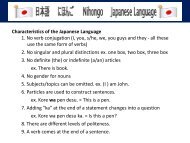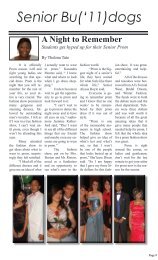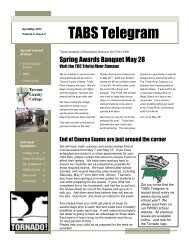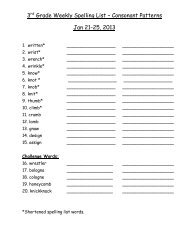The Effect of Sulfur Dioxide, Nitrogen Dioxide, and Carbon Dioxide ...
The Effect of Sulfur Dioxide, Nitrogen Dioxide, and Carbon Dioxide ...
The Effect of Sulfur Dioxide, Nitrogen Dioxide, and Carbon Dioxide ...
You also want an ePaper? Increase the reach of your titles
YUMPU automatically turns print PDFs into web optimized ePapers that Google loves.
<strong>The</strong> <strong>Effect</strong> <strong>of</strong> <strong>Sulfur</strong> <strong>Dioxide</strong>, <strong>Nitrogen</strong> <strong>Dioxide</strong>, <strong>and</strong><br />
Abstract:<br />
<strong>Carbon</strong> <strong>Dioxide</strong> On Caladium Plants<br />
By Audrey <strong>and</strong> Nadine<br />
We chose the project because it’s fun to work with. We did the project to see<br />
the effect <strong>of</strong> sulfur dioxide on plants. We polluted the plants. We <strong>and</strong> Mrs.Gordon<br />
doubled the amount <strong>of</strong> sulfur every day. When we stopped polluting the plants, we<br />
collected data <strong>and</strong> took pictures <strong>of</strong> the plant’s cell. Also it took us about three to<br />
four weeks to notice that the sulfur does not really help the plants but the plants<br />
died. <strong>The</strong> pollution starts showing on the plant cell by changing color from green<br />
to light brown.<br />
Introduction:<br />
Our research came from this article by Sonya 3 Die from Toxic gases At<br />
California Ski resort. When we finished reading that article we learned more about<br />
what the smell <strong>of</strong> sulfur <strong>and</strong> what the cause <strong>of</strong> death at the ski resort. We also read<br />
another article by Howie Icel<strong>and</strong> volcano fumes from EU. From this article we<br />
learned more about the ash that comes from the volcano. From this article we<br />
thought we probably could “copy cat” the sulfur <strong>and</strong> experiment on the caladium<br />
plant since this plant was already growing in the lab. This is the type <strong>of</strong> plant we<br />
are polluting. Our other resource was an article called “Volcanic fumes warning.”
From this article we noticed the fact is that volcanic fumes were hazardous to<br />
public health <strong>and</strong> volcanic fumes contain hydrochloric acid, carbon dioxide,<br />
sulfuric acid, <strong>and</strong> glass particles. This was very interesting to us. People died from<br />
carbon dioxide which we think was replaced with oxygen. Maybe there was too<br />
much carbon dioxide. Another good reference was “Volcanic gases <strong>and</strong> their<br />
effects.” From this article we took notes <strong>and</strong> learned that the air is 5% CO2 <strong>and</strong> if<br />
this gas increases to 6-10% this will cause shortness in breath, headaches,<br />
dizziness, <strong>and</strong> sweating. That is what could happen from exposure to the volcanic<br />
gases to humans. That is what happens from the emissions <strong>of</strong> volcanic gases.<br />
When we talked to our partnership, the Soltis Research Station in Costa<br />
Rica, they told us that the volcano is not near the backyards <strong>of</strong> people’s homes.<br />
<strong>The</strong> plants around the base <strong>of</strong> the volcano are fine. Also, in Costa Rica they told us<br />
that they try to control how much pollution comes from their cars <strong>and</strong> trucks.<br />
People in Costa Rica use more mass transit than the United States.<br />
Throughout the experiment we mostly recorded how much water the plants<br />
were getting, we made sure each plant receive the same amount <strong>of</strong> sunlight, <strong>and</strong><br />
took notes about the plants leaves. When we took notes on the plants we observed<br />
the gas effects on the leaves <strong>and</strong> noticed if the leaf’s condition looked ‘polluted’.<br />
We also had to check up on the plants every hour once we polluted the air. Now
that the experiment is over we know that sulfur dioxide (such as volcanic fumes) is<br />
harmful to the caladium if this plant was exposed to this gas for 5 or 4 hours.<br />
Helan J. Chall<strong>and</strong> A New True Book Volcanoes Canada children`s press 1983<br />
Neil Morris Volcanoes New York crabtree publishing company 1996<br />
Andres Liamas Ruiz Sequences <strong>of</strong> Earth & space, volcanoes &Earthquakes New<br />
York A division <strong>of</strong> Grolier publishing 1998<br />
(Plant C leaf piece under microscope at 10x. Not polluted)<br />
Problem: Volcanic gas fumes can be dangerous.
Hypothesis: Volcanic gas <strong>of</strong> sulfur dioxide is more dangerous than volcanic carbon<br />
dioxide on nitrogen dioxide because the natural air already has carbon dioxide in it.<br />
Objectives:<br />
Materials:<br />
1) To see the effects on a common tropical caladium from sulfur dioxide<br />
fumes<br />
2) To learn how to plot the measurement <strong>of</strong> sunlight exposure <strong>and</strong><br />
watering the plants.<br />
3) To study <strong>and</strong> compare the plant cells when exposed to different gasses<br />
<strong>of</strong> SO2 , CO2 , <strong>and</strong> NO<br />
2<br />
Five caladium plants, soil, 5 plant containers, hot plate, 100 ml cylinder beaker,<br />
ruler, sulfur pellets, journal, pencil, microscope, CO2 meter, SO2 Dosci tubes,<br />
mortar <strong>and</strong> pestle
Picture <strong>of</strong> Microscope similar to the microscope we used.(picture <strong>of</strong>f <strong>of</strong> Internet,<br />
http://www.amazon.com/Celestron-44102-Laboratory-Biological-Microscope/dp/B000Q7964S)<br />
Procedure:<br />
Part 1: Before you start labeling your plant you need to cut some <strong>of</strong> the plants. You<br />
get the five plants from this huge plant. You pull the single plant, put it in the black<br />
plastic pot <strong>and</strong> also put soil in the pot. <strong>The</strong>n water the plant. One you have done<br />
this then you can start the experiment.<br />
1) Part 2: <strong>The</strong> first step is labeling the five plants plant a, plant b, plant c, plant<br />
d <strong>and</strong> plant e. <strong>The</strong>n set them in different places that will give the plants even<br />
sunlight. Also to record the temp before you start polluting. You then ground<br />
up the sulfur pellets into powder. You should at least use about 60 grams <strong>of</strong><br />
sulfur pellets.
2) Second step is to read the instructions for the CO2 <strong>and</strong> SO2 tubes. Stick them<br />
some where you can read them with duck tape still showing the reading.<br />
3) Third step is to check on the two tubes every hour <strong>and</strong> record the reading in<br />
the journal.<br />
4) Fourth step if the plants don`t look polluted then start burning the sulfur.<br />
Make sure to weigh how much sulfur you will be burning. Record what time<br />
you burned the sulfur just in case you have to burn more sulfur the next day.<br />
Burn 32 grams <strong>of</strong> sulfur.<br />
5) Fifth step as the days roll by if there are some changes take note in the<br />
journal. When the plants start dying then you have finished the experiment<br />
then you now know what volcanic fumes can do to the plants.<br />
<strong>The</strong> actual cost <strong>of</strong> tubes =$10 eachX12 tubes=$120<br />
Cost <strong>of</strong> plant = $11.94<br />
Hot plate = $167.85<br />
<strong>Sulfur</strong> Pellets = $19.99~20<br />
Microscope =$ 174.89<br />
Light meter= $89
CO2 meter=$199<br />
Total cost <strong>of</strong> project =$ 782.67 * please note that many <strong>of</strong> the items were<br />
already in our science lab. We only had to spend $10.00 each for the Dosci<br />
tubes.<br />
Safety: When burning sulfur make sure you wear safety goggles <strong>and</strong> an adult is<br />
monitoring you while burning the sulfur. We also used the fume hood at first;<br />
however, we did want the fumes to go everywhere so we moved our<br />
experimental set up out <strong>of</strong> the hood.<br />
Close up <strong>of</strong> Plant C leaf under the microscope at 60x (before the plant was exposed to polluted<br />
gasses).<br />
DATA:
Date Identification<br />
<strong>of</strong> tube<br />
Observations &<br />
Recorded readings<br />
<strong>of</strong> gasses(ppm)<br />
10/1/2010 SO2 Color change<br />
(10ppm)<br />
NO Darkening<br />
2<br />
yellowish(
(3.0ppm)<br />
Plant Name Where the plant is located<br />
Plant A On top <strong>of</strong> soil bags where window is<br />
Plant B By the south window under a plant shelf<br />
Plant C On south window under plant shelf away from<br />
plant B<br />
Plant D On the ground on the short little stool<br />
Plant E Under the shower head<br />
Close up <strong>of</strong> Plant C leaf under the microscope at 200x (after the plant was exposed to polluted gasses).<br />
Notice the darker coloration <strong>of</strong> the top surface within the leaf.<br />
Calculations:<br />
Between the two gases <strong>of</strong> SO2 <strong>and</strong> NO2 the difference was:
low reading for SO2 = 10 ppm <strong>and</strong> high reading = 100ppm<br />
Range difference was 90ppm<br />
low reading for NO2 =
Graphs:<br />
m-2 s-1 is the unit <strong>of</strong> sunlight the plant is getting.
Observations: On plant C the plant cells looked healthily. <strong>The</strong> cells were the<br />
color green <strong>and</strong> light green. After polluting the plants with the SO2 I did not<br />
get any results. So I had to burn sulfur pellets. After a few weeks passed I<br />
started getting results. <strong>The</strong> plant cell started changing from light green to<br />
light brown. At that point I knew that the plant cells were getting enough<br />
pollution. I then looked at the other plant cells from the other plants. From<br />
the look <strong>of</strong> the results I then got my results for the after part.<br />
Discussion <strong>of</strong> results: Before we started polluting the plants, plant E died. We think<br />
because E was the smallest plant <strong>and</strong> there were some problems with the sunlight
<strong>and</strong> water. When we finished the project we still did not know what the problem<br />
with plant E was. When we talked about the plant she thought Plant E died because<br />
it was too near the door so kids who were coming into the lab may have played<br />
with this plant. Plant D started to grow after we polluted it with sulfur dioxide <strong>and</strong><br />
then after three weeks or four it start dying. Plant A was doing well at first <strong>and</strong> it<br />
was growing but then it started polluting <strong>and</strong> then it died. Plant B was doing good<br />
too but it did not grow very fast <strong>and</strong> then Plant B ended up dying. Also plant C was<br />
going very well <strong>and</strong> was the tallest plant, the pollution did not show very much<br />
until the end <strong>of</strong> the project. At the end <strong>of</strong> the project Plant C died because when we<br />
took Christmas break we did not get a chance to water it.<br />
Explanation <strong>of</strong> graph: This graph represents the plant growth in inches during our<br />
project. You can see that the plant that grew the most was plant D. it was the tallest<br />
plant between the plants. <strong>The</strong> shortest plant was (plant E) it was the one that died<br />
the quickest when compared to the other plants.<br />
Explanation <strong>of</strong> temperature conversion: <strong>The</strong> formula for converting Celsius to<br />
Fahrenheit is Tf= (9/5)*Tc+32. For using this formula you have to use pemdas.<br />
Which is Prentices, Exponents, multiply, divide, add <strong>and</strong> subtract. First you divide<br />
9 by 5. You will get 1.8. Next multiply 1.8 by 19.5. You should get 35.1. <strong>The</strong>n you<br />
have to add 35.1 <strong>and</strong> 32 together. <strong>The</strong> Fahrenheit you should get 67.1 as the<br />
answer. You use the same process for 19.6. For the Fahrenheit the answer should<br />
be 67.28.<br />
We also realized that the CO2 was changing every day, actually every half an hour,<br />
we also noticed that the when the CO2 in the room changes the plant changes. <strong>The</strong><br />
last week before the plants died they stopped growing, which makes you think that<br />
the sulfur dioxide makes the plant grow fast at first but then they stop growing.<br />
Now we know that the sulfur doesn’t help the plants at all.<br />
Conclusion:
At first, we made a hypothesis about the sulfur dioxide harming the plant<br />
instead <strong>of</strong> carbon dioxide <strong>and</strong> nitrogen dioxide. From the data, we learned<br />
that the sulfur dioxide does not help the plant at all. <strong>The</strong> reason why is that<br />
we thought the sulfur may help the plant because it increases the acid in the<br />
air <strong>and</strong> soil so this plant would do better in a decrease <strong>of</strong> pH conditions. We<br />
saw in the following days <strong>of</strong> polluting the science lab the plants looked more<br />
healthy than polluted to us. <strong>The</strong>n a few more weeks <strong>of</strong> polluting the plants<br />
the plants then started looking poorly. <strong>The</strong> fourth day the plants slowly<br />
started to get polluted <strong>and</strong> the plant cells changed in color <strong>and</strong> shape. <strong>The</strong><br />
began to turn slightly brown.<br />
1) To see the effects on a common tropical caladium from sulfur dioxide<br />
fumes<br />
In the project we did end up using SO2,, NO2 ,<strong>and</strong> CO2 <strong>and</strong> sulfur pellets<br />
which we ground up into a powder to burn. We also recorded what the<br />
effects <strong>of</strong> the tropical plants did when they were polluted. Take for example<br />
the tallest plant (Plant D) must have taken the most time before the leaves<br />
were showing any results. After Christmas break <strong>and</strong> about three weeks<br />
Plant D was starting to show some results. <strong>The</strong> leaves started to change from<br />
healthy green to light polluted brown. We think it was the sulfur dioxide<br />
since this gas had the highest reading on the Dosci tubes rather than the
carbon dioxide <strong>and</strong> the nitrogen dioxide. Further testing would really be<br />
needed to pinpoint the exact gas, but with our collection <strong>of</strong> data, that is what<br />
we think.<br />
2) To learn how to plot the measurement <strong>of</strong> sunlight exposure, <strong>and</strong> watering<br />
the plants.<br />
During the project we did end up learning how to plot the measurement<br />
<strong>of</strong> sunlight exposure <strong>and</strong> watering plants. At the end <strong>of</strong> the project we<br />
had to type up a research paper. In the paper we had to include a graph<br />
about the measurement <strong>of</strong> sunlight <strong>and</strong> sunlight exposure <strong>and</strong> the<br />
watering <strong>of</strong> the plants. So then on the computer we had to plot the<br />
measurement <strong>of</strong> sunlight <strong>and</strong> sunlight exposure <strong>and</strong> watering the plants.<br />
3) To study <strong>and</strong> compare the plant cells when exposed to different gasses<br />
<strong>of</strong> SO2 , CO2 , <strong>and</strong> NO2.<br />
Before we had to start the project we had to study about SO2,<br />
CO2 <strong>and</strong><br />
NO2. Once a few weeks past <strong>of</strong> doing the project we then stated to look<br />
at plant cells under a microscope. We looked at the plant cells before<br />
polluting <strong>and</strong> recording what we saw. <strong>The</strong>n when we polluted the plant<br />
cell we then took another look at the plant cell after polluting it with<br />
SO2, CO2 <strong>and</strong> NO2.
At first all the plant cells looked the same for a few weeks when all the<br />
plants were healthy. When the plants started getting polluted we then started<br />
getting results. Plants A, B were not showing any brown color at all. When we<br />
looked at plants C <strong>and</strong> D we started to see some light brown color. Probably plants<br />
A <strong>and</strong> B weren`t really close to where the sulfur pellets were fuming. For plants C<br />
<strong>and</strong> D they were some where close to the sulfur to even get polluted. By the end <strong>of</strong><br />
the experiment plant E was completely polluted.<br />
Annotated References:<br />
1. Costa Rica Field Trip<br />
• We did not actually go to Costa Rica. We went to a<br />
conference room for a video com.<br />
• <strong>The</strong>re we got to listen to some <strong>of</strong> the students about the<br />
volcano there.<br />
2. http://pollution-plants.blogspot.com/<br />
• Seedlings are little pods <strong>and</strong> are more sensitive to SO2 Than<br />
older plants.<br />
• <strong>The</strong> NO2<br />
gas will affect the plants <strong>and</strong> seedlings.<br />
3. http://www.windows2universe.org/earth/Atmosphere/pollution_eff<br />
ects_overview.html&edu=high&links=/wildlife_forests.html
• Pollution can harm plants <strong>and</strong> animals.<br />
• Pollution can also harm Earth`s climate.<br />
4. http://www.healthguidance.org/entry/8523/1/Plants-That-Will-<br />
Withst<strong>and</strong>-Pollution-And-Reduce-It.html<br />
• <strong>Nitrogen</strong> dioxide can stop plant growth without any change<br />
to the leave.<br />
• <strong>Sulfur</strong> dioxide can produce markings on the leaf leaving<br />
damage to the leaf.<br />
5. http://www.catf.us/resources/publications/view/3<br />
• Power plants produce sulfur.<br />
• <strong>Sulfur</strong>ic acid damages our environment.<br />
6. http://5e.plantphys.net/article.php?ch=e&id=262<br />
• Pollution can even stop plant growth<br />
• Vegetation starts to slow down just by air pollution<br />
7. http://whqlibdoc.who.int/monograph/<br />
• Pollution may not be bad to health but probably can cause<br />
some damage.<br />
• <strong>The</strong>re are two different kinds <strong>of</strong> air pollution.<br />
8. http://volcanoes.usgs.gov/hazards/gas/index.php<br />
• Hazards <strong>of</strong> pollution<br />
• <strong>Effect</strong>s <strong>of</strong> volcanic gases<br />
9. http://environment.nationalgeographic.com/environment/globalwarming/pollution-overview.html<br />
• Fossil fuels make air pollution<br />
• Very effective to environment<br />
10. http://www.westonaprice.org/environmental-toxins/249fluoride-worse-than-we-thought.html<br />
• Affects humans if inhale too much<br />
• Can affect the human body inside
11. http://www.greatdreams.com/red_warning.htm<br />
• Warning <strong>of</strong> pollution destroying the earth<br />
• Pollution affects weather changes<br />
12. http://volcanoes.usgs.gov/hazards/gas/index.php<br />
• Air 5% CO2 increase 6-10% in human health<br />
• Talks about CO2<br />
13. http://en.vedur.is/earthquakes-<strong>and</strong>-volcanism/articles/nr/1884<br />
• Ash mist light brown<br />
• Ash cloud dark brown<br />
Acknowledgements Parents for helping type the paper, Mrs.<br />
Gordon for helping a lot on the paper suggesting corrections <strong>and</strong><br />
for being the teacher, Librarians for having the text books , partner<br />
for helping collect data <strong>and</strong> doing the references <strong>and</strong> the graphs,<br />
internet for typing up paper <strong>and</strong> Costa Rica for volcano<br />
information.
















